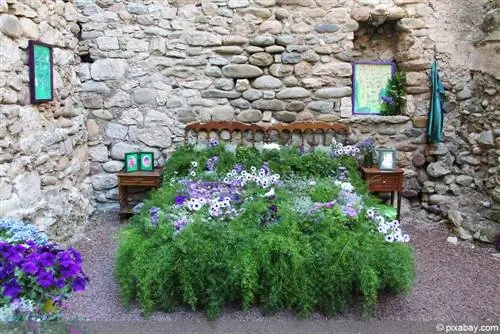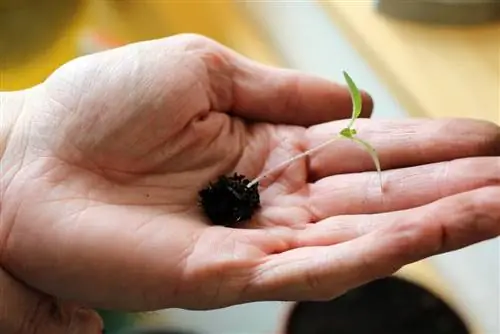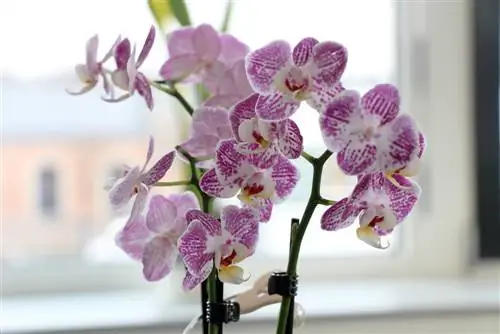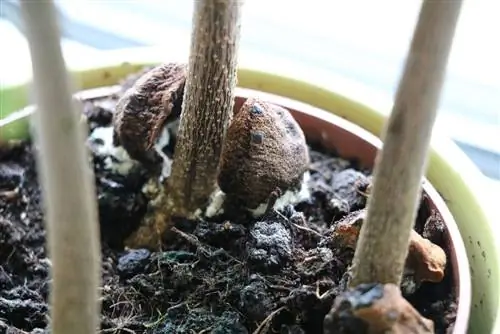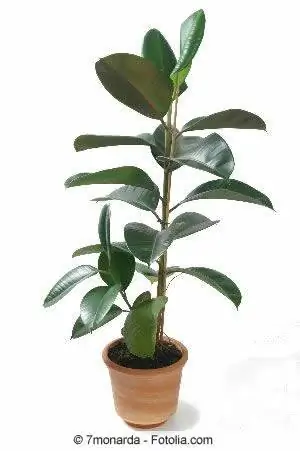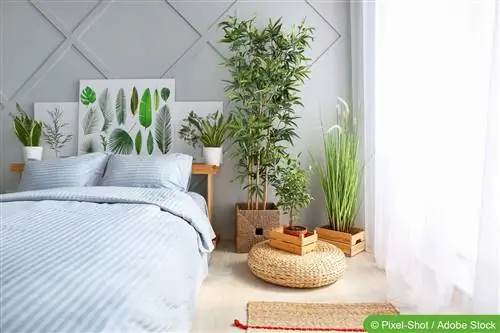- Author admin [email protected].
- Public 2023-12-17 03:39.
- Last modified 2025-01-24 12:45.
If you want to decorate your bedroom with the pretty ornamental plants, you can do something good for yourself at the same time! Plants have been proven to improve the air quality of a room, and some of them can even filter pollutants from the air. Below you will find a list of plants that are particularly suitable for the bedroom. But be careful: plants in the bedroom are not always a good choice!
Plants improve air quality
Good, restful sleep depends on many factors. The air quality within the bedroom plays a major role here: in order to sleep particularly well, a sufficient amount of oxygen with the lowest possible carbon dioxide concentration is necessary. If the carbon dioxide content in the air is too high, the human body goes into so-called “low-burn mode”. Despite getting enough sleep, those affected are not well rested and feel exhausted. However, a NASA study has confirmed that the air quality of a room can be significantly improved with the help of plants:
- Plants absorb carbon dioxide
- and release oxygen
- most plants stop photosynthesis at night
- However, there are some plants that also release oxygen at night
- these are called CAM plants
Numerous plants can also filter pollutants such as trichlorethylene, formaldehyde and benzene from the air. These get into the air through cleaning agents, paints, adhesives or cigarette smoke, among other things, and can cause he alth problems. Some of the symptoms include irritation of the eyes, nose and mouth, headache, dizziness and nausea.
11 ideal plants for the bedroom
NASA generally recommends between 15 and 18 air-purifying plants in a living space of around 170 square meters. Accordingly, there should be at least one air-purifying plant in a room of approximately 9 square meters. NASA also conducted a study to test which plants improve air quality the most. Below you will find a list of decorative plants for the bedroom that have a positive effect on air quality:
Aloe vera
The healing effects of aloe vera are now widespread, which is why the medicinal plant often finds its way into the living room at home. The plant also helps to improve the air in the room because it filters the substance formaldehyde from the air. If you are looking for a plant for the bedroom, aloe vera is also a good choice. Aloe vera is one of the CAM plants and therefore has the ability to release oxygen even at night. This improves the air quality in the bedroom, which in turn promotes a restful sleep.
- Latin name: Aloe vera
- Synonyms: True Aloe
- Genus: Aloes (Aloe)
- Growth height: 40 to 50 centimeters
- Special features: Liquid from the leaves has healing effects
Tip:
The liquid in the leaves can help with small cuts or burns. To do this, a piece of the leaf is cut off and the liquid is then smeared on the affected area.
birch fig
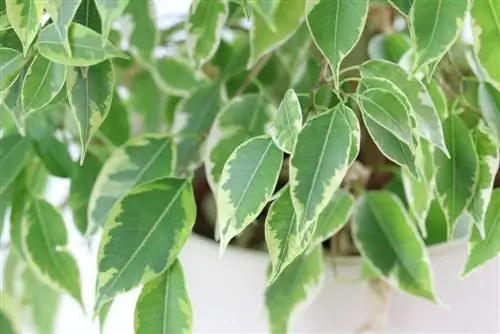
The birch fig is a pretty, green tree with slightly wavy leaves. In addition to the decorative aspect, the plant also has the advantage of being particularly effective at filtering pollutants from the air. In order to take advantage of the positive effect of the plant, it is necessary to place it in a bright, draft-free, fixed location. The birch fig does not tolerate both a quick change of location and a lack of light well. Therefore, especially in the dark winter months, the tree may shed its leaves due to the lack of light.
- Latin name: Ficus benjamina
- Synonyms: Benjamini
- Genus: Mulberry Family (Moraceae)
- Growth height: 2 to 5 meters
- Special features: can cause allergies
bow hemp
The arched hemp is one of the most popular houseplants, and rightly so! Because it is not only easy to care for, but is also extremely decorative. In addition to its pretty appearance, it also has the ability to release oxygen and absorb carbon dioxide at night. On top of that, the plant can filter common household toxins from the air and help with headaches and high blood pressure. If the bow hemp is placed in a bright location and watered once a week, it can make a significant contribution to improving air quality.
- Latin name: Sansevieria
- Synonyms: mother-in-law's tongue
- Genus: Asparagus family (Ruscaceae)
- Growth height: 10 to 80 centimeters
- Special features: is poisonous to people and pets
Chrysanthemum

The chrysanthemum is a perennial houseplant and originally comes from Asia. In local regions it is mostly grown as an annual plant on the balcony or garden. However, it can also be cultivated indoors without any problems, as long as the temperatures are not permanently above 15 degrees. The plant does particularly well in a sunny to partially shaded spot in the bedroom. If the chrysanthemum is placed in the bedroom, it also ensures a restful sleep. Because the colorful plant has the ability to filter pollutants from the air.
- Latin name: Chrysanthemum
- Genus: Daisy family (Asteraceae)
- Growth height: 30 to 60 centimeters
- Special features: Touching the plant can cause skin irritation in allergy sufferers
Efeutute
The evergreen ivy is the ideal plant for the bedroom because it also thrives in shady places. It is also extremely easy to care for because it only needs a little morning sun and only needs to be watered once a week. If the climbing plant is cared for professionally, it not only decorates the bedroom with its attractive foliage, but also filters harmful benzene from the air.
- Latin name: Epipremnum
- Synonyms: gold vine, tonga plant
- Genus: Arum family (Araceae)
- Growth height: up to 3 meters
- Growth habit: climbing plant
- Special features: toxic to humans and pets
Single sheet
There are around 50 to 60 species of the single leaf, which occur from tropical America to the Solomon Islands. Depending on the species, the single leaf has either decorative leaves or long-lasting inflorescences, which is why it is often kept as a houseplant in local regions. The pretty plant not only serves as an eye-catcher, but also improves the air quality in the room. The leaf extracts harmful substances, such as benzene and formaldehyde, from the air. Their flowers also release moisture, which in turn can suppress allergy-causing germs in the air. The leaflet not only promotes a restful sleep, but also prevents the nose and eyes from drying out.
- Latin name: Spathiphyllum
- Synonyms: leaf flag, peace lily, cutting leaf, column flower
- Genus: Arum family (Araceae)
- Growth height: 40 to 80 centimeters
- Special features: can cause allergies
Ivy

Ivy does not need much sun and grows best at a temperature of 10 to 18 degrees. The bedroom is therefore ideal as a location for the easy-care plant. There it not only serves as an eye-catcher, but also frees the air from impurities. It also regulates the humidity within the room and has a positive effect on the symptoms of allergies and asthma.
- Latin name: Hedera helix L.
- Synonyms: evergreen, climbing ivy, wintergreen, wall peacock, eppig
- Genus: Ivy family (Araliaceae)
- Growth height: up to 20 meters
- Special features: toxic to humans and pets
Gerbera
The Gerbera grows in the wild mainly in Madagascar, Africa and tropical Asia. There are now around 30 known species of this pretty plant, which are perennial and not hardy. Thanks to their colorful flowers, the gerbera is very popular. If the gerbera is placed in the bedroom, it ensures a restful sleep. The plant releases a lot of oxygen, making it easier to breathe while sleeping. It is therefore ideal for people who suffer from apnea (stopped breathing) and is also the ideal plant for the bedroom for allergy sufferers.
- Latin name: Gerbera
- Genus: Daisy family (Asteraceae)
- Special features: can bloom all year round
Green Lily

The spider plant is a fast-growing plant that is ideal for beginners. Because the evergreen plant forgives one or two care mistakes. If it is placed in a bright location and cared for professionally, it not only decorates the room, but also improves the air quality. The spider plant absorbs both odors and pollutants from the air. A NASA study found that the plant removes around 90 percent of the substance formaldehyde from the air.
- Latin name: Chlorophytum comosum
- Synonyms: bridal train, Green Henry, grass lily
- Genus: Lily family (Liliaceae)
- Growth height: 30 to 40 centimeters
- Special features: is also suitable as a hanging plant
Jasmine
The exotic plant impresses with its ivory-colored flowers, which also exude a pleasant scent. For many people, this scent has a calming and sleep-inducing effect, which is why jasmine is often kept in the bedroom. However, people who are sensitive to smells should use the plant with caution as their sleep could be disturbed by the scent. If you decide to keep your indoor jasmine, you should place it in a bright spot with lots of daylight and water it regularly.
- Latin name: Jasminum
- Synonyms: room jasmine, scented jasmine
- Genus: Oleaceae
- Growth height: up to 2.5 meters
- Special features: used to produce essential oils
Lavender
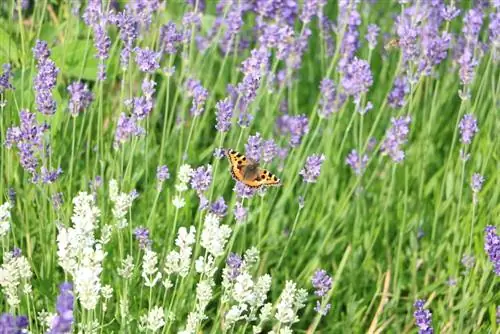
Lavender has had an established place in aromatherapy for many centuries. Nowadays, lavender is often used for sadness, depressive moods or increased blood pressure. The scent of this plant is calming and relaxing and promotes sleep. Accordingly, lavender placed in the bedroom can have a positive effect on sleep. However, people who are sensitive to smells should not keep lavender in their bedroom.
- Latin name: Lavandula angustifolia
- Synonyms: True lavender, narrow-leaved lavender
- Genus: Mint family (Lamiaceae)
- Growth height: 60 to 100 centimeters
- Special features: serves as a medicinal and culinary herb
Tips for plants in the bedroom
Although most people benefit from plants in the bedroom, there are some exceptions. In particular, people who have a house dust allergy or suffer from hay fever should avoid plants in the bedroom. It is not uncommon for plants to serve as a collection point for pollen or dust and can therefore trigger allergic reactions. People who are sensitive to smells should also avoid fragrant plants in their bedroom, as the scent can cause headaches. If you decide to keep plants in your bedroom, you should also pay attention to the following:
- many plants increase the humidity
- this increases the risk of mold
- therefore ventilate regularly
- conventional potting soil can contain fungal spores
- better: clay granules or potting soil made from coconut fibers
- Do not place plants directly next to the head
- move diseased plants out of the room

